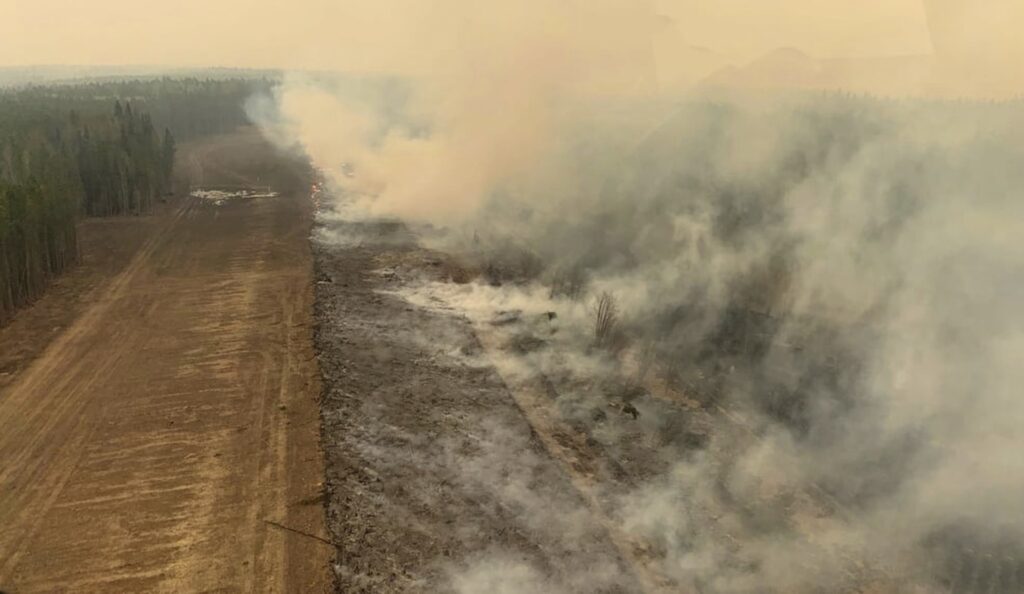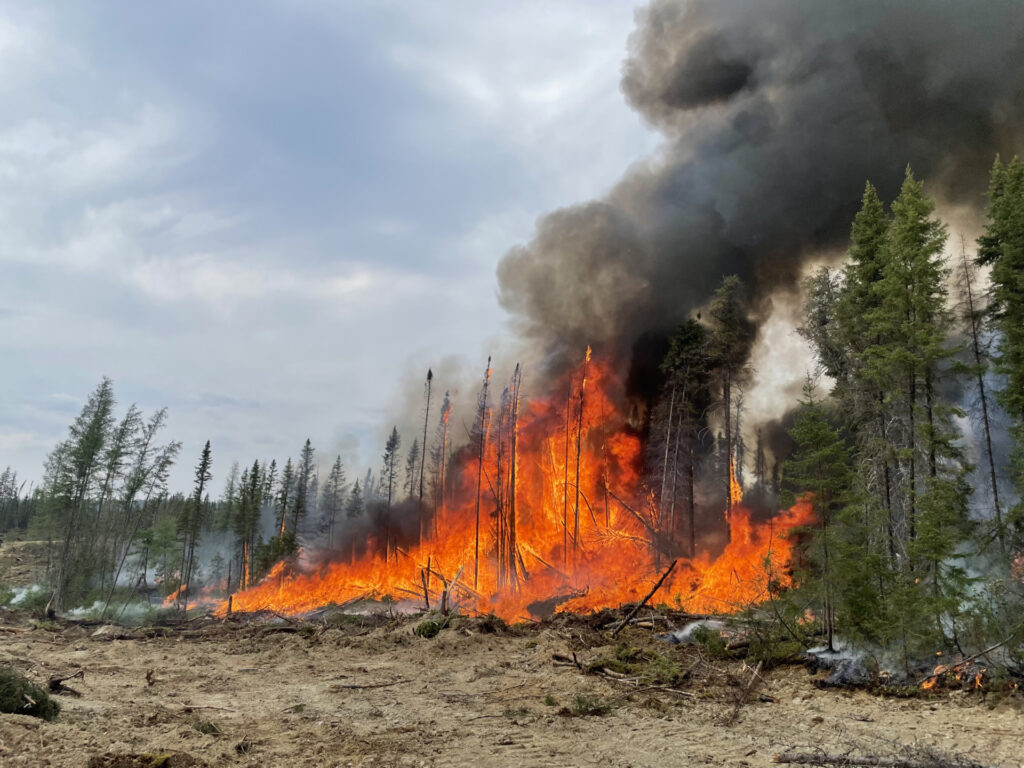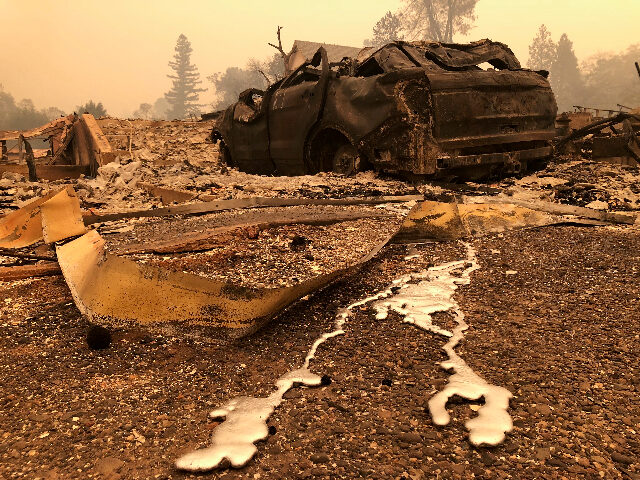Lisa Mundy, a mother of two from Hay River in Canada’s Northwest Territories (NWT), recounted Wednesday one of the most harrowing escapes from the massive Canadian wildfires: she and her family drove through the inferno in a car that was literally melting around them.
Mundy told Canada’s CBC News that her community received an evacuation order at 3:00 p.m. on Sunday afternoon. The advancing wildfire soon closed some of the roads out of town. Others were bathed in searing heat and clouds of impenetrable smoke.
“You couldn’t see anything – we were driving through embers. I was obviously scared the tire was going to break, our car was going to catch on fire, and then it went from just embers to full smoke,” she said.
Mundy recalled her six-year-old son repeatedly saying, “I don’t want to die, Mommy.” She and her husband struggled to drive along the edge of the fire with a window cracked for air, but the smoke became unbearable — and then Mundy noticed the car was melting. The rear-view mirrors looked like misshapen lumps of clay by the time they got clear of the fire, pushing on to safety in Alberta.

In this photo provided by the Government of Alberta Fire Service, a burned section of forest in the area near Edson, Alberta, smolders on May 6, 2023. (Government of Alberta Fire Service/The Canadian Press via AP)
“It was honestly insane. When I got out of our vehicle in Enterprise, I just cried,” she said.
Mundy was not the only evacuee to describe a melting car.
“There were vehicles that had melted lens covers on their headlights, tail lights, all the paint on the side of their vehicles was all, like, crackled up and busted up. We knew that people had come through some pretty harrowing experiences to get from Hay River,” said another area resident, Jane Groenewegen of Enterprise.
Groenewegen said she was urged to evacuate immediately by a Royal Canadian Mounted Police (RCMP) officer, whose radio reported the advancing fires were shutting down roads as he spoke to her. The mayor of Enterprise said the town was “90% gone” on Tuesday.
RELATED: MASSIVE Smoke Cloud BLOTS OUT THE SUN as Thousands Evacuate over Nova Scotia Wildfire
NWT Premier Caroline Cochrane told CBC that too many people delayed evacuating for civic-minded reasons, but the best thing to do in such a disaster situation is to leave when instructed.
“When people decide to stay, and it’s all good intentions, they decide to stay and help others, or they decide to stay to protect their property, they’re actually putting more people at risk,” she said.
“Not only do our emergency supports have to focus on fighting the fire, we also have to provide support to make sure that people that aren’t part of the emergency response are safe,” she explained.

A view of wildfires at Lebel-sur-Quevillon in Quebec, Canada on June 23, 2023. (FREDERIC CHOUINARD /SOPFEU / Handout/Anadolu Agency via Getty Images)
NWT fire information officer Mike Westwick said the fires could reach the outskirts of Yellowknife, the provincial capital, this weekend unless they are stopped by much-needed rain. Environment Minister Shane Thompson agreed, warning the fires have “taken another turn for the worse.”
“I want to stress that the city is not in immediate danger,” Thompson said, adding that residents in the path of the blaze who delay evacuation could put themselves and others at risk.
The entire city of Yellowknife and many of its outlying communities were under evacuation alert as of Thursday afternoon, and a massive airlift operation was underway, said to be the largest in NWT history. About half of the residents of the Northwest Territories live in Yellowknife.
“If you are able to evacuate by road, obey all warning signs, emergency management officials, traffic control devices and posted speed limits. Do not make any rash decisions that can put other people in danger,” Premier Cochrane urged.
CBC said evacuees were forming camper and tent cities and using social media to keep in touch with family members. Some worried about friends and family who could no longer communicate as the fires knocked out lines and towers in their communities.
Smoke and particulates from the Canadian fires triggered air quality alerts in Minnesota on Thursday and Friday. Residents were advised to remain indoors as much as possible while smoke blanketed most of the state. The Twin Cities posted their tenth air quality red alert of the summer on Thursday.
RELATED — BLADE RUNNER NYC: Canadian Wildfire Smog Casts Dystopian Hue over Big Apple
The administration of Prime Minister Justin Trudeau has been criticized for its haphazard response to Canada’s worst wildfires in recent memory, leaving provincial officials to develop their own conflicting policies. Local officials have struggled to organize hundreds of firefighters from Canada, the United States, and nearly a dozen other countries effectively.
Although left-wing officials in both Canada and the U.S. prefer to blame “climate change” for the fires, Canada’s lax forest management policies, lack of a national fire management service, and underfunded local services were clearly factors in the record-breaking fire season. Some frustrating decisions have been made as the crisis unfolds, such as Quebec refusing timely assistance from Montreal because it preferred to wait for French and American firefighters.

COMMENTS
Please let us know if you're having issues with commenting.